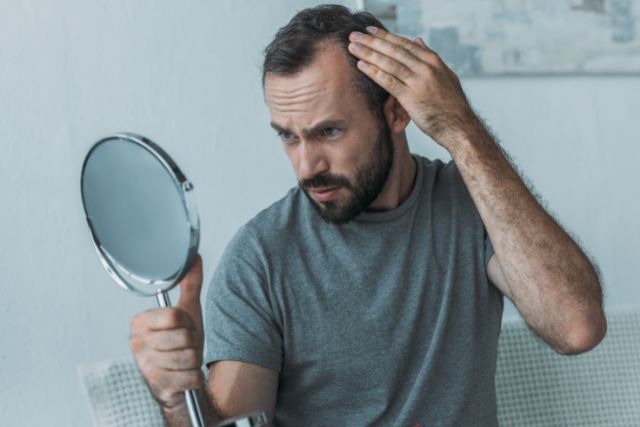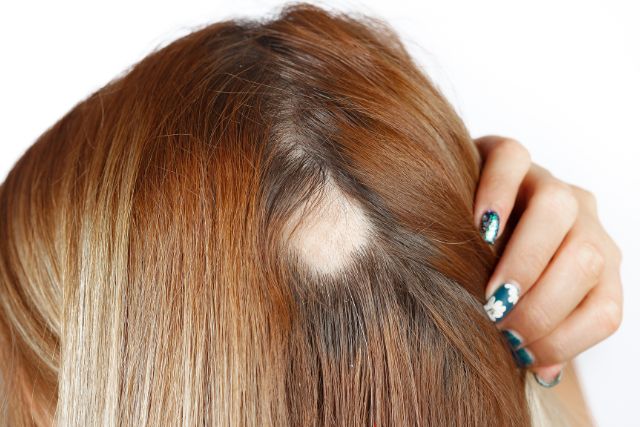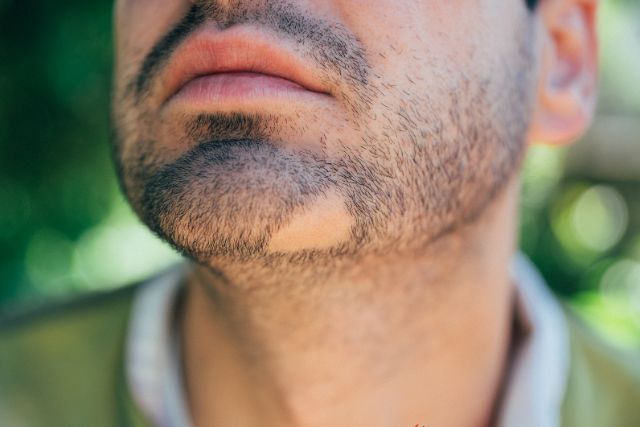Temporal Triangular Alopecia: Meaning, Causes, Treatment, and More
- Written by Vivek Khullar
- Aug 17, 2024
- |
- 13 min read
 Listen to the full text
Listen to the full textNotice hair thinning around your hairline? While there could be many reasons for this, we will be talking about temporal triangular alopecia today. A lot of people don’t know about this hair loss problem, and this sometimes makes them miss out on seeking timely help. But don’t worry, we are here to guide you!
In this blog, Lordhair will explain everything about temporal triangular alopecia. What causes it, what it looks like, how to manage it - we will cover all crucial aspects! By the end of this read, you will be able to make informed decisions about caring for your hair.
Are you in a hurry to learn about it? Well, here’s a FAQ version of the article.
What is temporal triangular alopecia?
This is a hair loss condition that creates a distinct triangular bald patch on the scalp, usually near the temples.
What causes temporal triangular alopecia?
The exact cause is unknown but it is believed to be congenital or related to skin development.
What are the symptoms of temporal triangular alopecia?
You will notice a triangular-shaped bald patch on the front of your scalp, usually near your temples. The good news is that the hair loss doesn’t spread to other parts of the head.
What is the difference between temporal triangular alopecia and alopecia areata?
Alopecia areata causes round or oval hair loss patches anywhere on the scalp. Temporal triangular alopecia, on the other hand, creates triangular patches near temples. Alopecia areata is an autoimmune condition while the cause of the latter is unknown.
Is triangular alopecia permanent?
Yes, triangular alopecia is usually permanent. In simple words, hair doesn’t grow back on its own. However, different treatments can help men and women manage their appearance and restore confidence.
What are treatments for temporal triangular alopecia?
The following treatments can help you deal with temporal triangular alopecia:
· Observation
· Minoxidil
· Corticosteroids
· Partial hair systems
· Scalp micro pigmentation
· Surgical excision
· Hair transplantation
· Low-level laser therapy
· Platelet-rich plasma therapy
· Camouflage products
Now that we are done with the TL;DR version, let’s address the same questions with added details.
What is Triangle Shape Alopecia?
Triangular-shaped alopecia is a type of hair loss that creates a distinct triangular-shaped bald patch on the front of your scalp. Also called temporal triangular alopecia, the patch is usually found near the temples. Scientists believe that it doesn’t spread to the other parts of your head.
But wait, why does it even happen? We know, we know - it’s a mystery wrapped in an enigma, a question that has puzzled many. But not anymore! Let’s delve deeper into this perplexing hair loss puzzle.

What is the Cause of Temporal Triangular Alopecia?
Unfortunately, the exact cause of this hair loss condition remains a mystery to dermatologists. While there are a few theories, none have been definitively proven. For instance, one theory suggests that it might be a congenital condition. Meaning, you’re born with it.
This is supported by many people noticing hair loss from birth or early childhood. Another possibility is that it’s related to the abnormal development of the outlayer of skin on the scalp. Some research indicates a possible genetic link to temporal triangular alopecia. Yes, you read it right! This condition can sometimes run in families.
It is also important to note that temporal triangular alopecia has been observed in people with certain conditions like down syndrome and phakomatosis pigmentovascularis, they don’t necessarily lead to hair fall in men and women.
Frustrating not to have a clear answer, right? We can understand that. But hey, you know what’s the good news? Temporal triangular alopecia is generally harmless. It doesn’t affect your overall health.
What are the Symptoms of Temporal Triangular Alopecia?
The most noticeable symptom of temporal triangular alopecia, as the name suggests, can be a triangular-shaped patch of hair loss on your scalp. This patch is usually located near your temples, as we said earlier. The hair doesn’t spread to other parts of the head, however.
The shape of hair loss can also vary. While it’s typically triangular, it can also be oval or round. What’s more, hair within the affected area is often very fine and thin. Or there might be no hair at all.
Another characteristic of temporal triangular alopecia among men and women is that hair loss is usually stable. In simple words, if hair fall takes place, it won’t worsen over time. In fact, you won’t face any other symptoms like itching, redness, or pain on the scalp.
But if you still notice a triangular patch of hair loss in your scalp, better consult a dermatologist. They will give you a proper diagnosis.
What is the Difference Between Alopecia Areata and Triangular Alopecia?
Although both alopecia areata and temporal triangular alopecia are indeed both hair loss conditions, they have distinct characteristics. Here, we have explained these two conditions for accurate diagnosis and appropriate treatment:
1 Shape of hair loss
As we said before, temporal triangular alopecia results in a triangular-shaped patch of hair loss. It is typically located near temples. Hair fall is usually stable and does not spread to other parts of the scalp. The same, however, can’t be said for alopecia areata!
It causes round or oval bald patches that can appear anywhere on the scalp. Unlike temporal triangular alopecia, alopecia areata can progress to total hair loss (also called alopecia totalis) or complete body hair loss (also called alopecia universalis).
2 Cause
The exact cause of temporal triangular alopecia is unknown, as we mentioned before. Usually, it is believed to be congenital (present from birth) or related to abnormal skin development at the front of the scalp. Alopecia areata, on the other hand, occurs when your body’s immune system mistakenly attacks your hair follicles. Thus, leading to hair loss.
3 Symptoms
The primary symptom for the former is a triangular hair loss patch. There are usually no other associated symptoms. Talking about alopecia areata, well, people may experience itching, burning, or tenderness of the scalp (in addition to hair fall). Some individuals may also develop nail changes.
4 Progression
When it comes to progression, the temporal triangular hair loss is known to be stable. It doesn’t worsen over time. Hair loss in alopecia areata can progress rapidly and unpredictably. New patches may appear while existing patches may grow or shrink.
Is Triangular Alopecia Permanent?
Sadly, Yes. Triangular alopecia is usually permanent. This means hair doesn’t grow back on its own. However, one should also understand that this type of hair loss is not a sign of a serious health condition. Also, it doesn’t cause any other physical symptoms.
While it might be disappointing to hear all this, there’s no need to worry. There are several treatments available that can help you manage your appearance of hair loss. Let’s discuss it in our next section!
Make sure to check out these sources as well:
Best diet, hair care, and styling tips for hair recovery
Men’s glue-on hairpieces that look absolutely amazing!
Everything about a bald spot on the crown of the head
Glueless lace human hair wigs for women
A complete guide to different types of alopecia
What are Treatments for Temporal Triangular Alopecia?
Yes, there’s no definitive cure for temporal triangular alopecia. However, several options can help manage its appearance. Here are some:
1 Observation
Often, the most recommended initial step is to observe the hair loss simply. Your hair loss condition should remain stable now that you know temporal triangular alopecia typically doesn’t progress. Regularly monitor your scalp to detect any unexpected changes. If you see a progression, consider our next option.
2 Minoxidil
Okay, we bet most of you are aware of this type of medication. For those unaware, let us tell you that Minoxidil is a topical medication primarily used to treat pattern baldness in men. How does it work, you ask? It does its magic by prolonging the hair growth phase, increasing hair thickness in the process.
While primarily studied for other hair loss conditions, some people with temporal triangular alopecia have reported positive results with minoxidil. However, be careful as this medication has its share of side effects too!
You can read this blog to learn about minoxidil's side effects.
3 Corticosteroids
Next up on our list is corticosteroids. It’s an anti-inflammatory medication that can be applied topically or injected directly into the affected area. By reducing inflammation, it potentially stimulates hair growth. However, the effectiveness of corticosteroids in treating temporal alopecia is limited.
Besides, long-term use can have side effects. Corticosteroids can cause:
- Stinging
- Burning
- Irritation
- Dryness
- Redness at the application site
- Acne
- Unusual hair growth
- Small red bumps on the skin (folliculitis)
- Skin thinning
- Stretch marks

4 Partial hair systems
Okay, we know you’re worried about the side effects of medications. What if we told you that there’s a non-surgical way to regain hair quickly? And without any side effects?
*Enter partial hair systems*
Also called hairpieces, toupees, or toppers, these are non-invasive solutions for frontal hair fall caused by temporal triangular alopecia. It is made using a thin, breathable base with human hair knotted or injected strand by strand. This creates a hyper-realistic hairline that seamlessly blends with existing hair.
Lordhair offers partial hair systems that are epitome of comfort and durability. Crafted using 100% human hair, they look and feel incredibly natural. And if you think that’s it, you’re wrong! Our systems are also customizable. Meaning, you can choose the exact hair color, length, base size, and many more options to meet your desired look.
The best part? Our partial hair systems are easy on your pocket without compromising the quality.
Browse our complete collection of hair systems and hairpieces for men
5 Scalp micropigmentation
A cosmetic procedure that involves depositing tiny pigments into the scalp so that it can mimic hair follicles' appearance. Meaning, it creates the illusion of a full head of hair. A highly effective solution for temporal triangular alopecia. It’s a permanent procedure and has side effects as well. So, make sure to consult with your dermatologist to carefully consider the decision.
6 Surgical excision
Surgical excision can also be considered for smaller areas of hair loss. We know many of our readers haven’t heard about it. Well, this treatment involves removing the affected skin and closing the area. While it can be effective in removing a hairless patch at the front, it might leave a scar.
7 Hair transplantation
Alright, this one is a more invasive procedure that involves moving follicles from the donor area (usually back of your head) to the affected area. This is a permanent solution but it requires multiple sessions and can be costly. Results can indeed be natural-looking but one should also consider complications of hair transplant.
Most common side effects of this surgical treatment include:
- Swelling
- Bleeding
- Itching
- Cursting
- Shock loss and hair loss
- Rare complications like infection
8 Low-level laser therapy (LLLT)
Another treatment to consider for fixing temporal triangular alopecia in 2024. LLLT involves using low-level lasers to stimulate hair growth at the front of your scalp. The red laser light comprises photons that get irradiated into scalp tissues. These photons are then absorbed by weak cells to encourage hair growth.
Although this procedure is generally safe, tolerable, and less invasive than a transplant, getting a 100% positive result is still a concern with this hair recovery treatment.
9 Platelet rich plasma
Our list will be considered incomplete without talking about platelet-rich plasma therapy for temporal triangular alopecia. It involves extracting your blood which then gets processed into concentrated platelets. A dermatologist then injects these into your scalp. Platelets contain growth factors that can potentially stimulate hair growth.
Here, learn everything important about PRP hair treatment!
10 Camouflage products
Camouflage products like hair fibers and concealers also offer temporary solutions for disguising hair fall caused by triangular alopecia. One can apply and remove these products easily. They come in various colors to match your hair. But are they cost-effective? Of course not since they don’t provide you a permanent solution to hair fall. Camouflage products require continuous use and expenditure.

Temporal Triangular Alopecia: Final Words
Above are some treatments to consider for dealing with temporal triangular alopecia. While some might require significant time and investment, others offer quick and affordable results. Ultimately, the best choice depends on your needs and preferences.
If you’re looking for a safer, non-surgical, and cost-effective solution, Lordhair’s partial hair systems will be the perfect fit! Our units, both stock and custom, are designed to restore your confidence and give you hair you deserve.
Ready to take the next step? Explore our range of partial non-surgical replacements and find the perfect match for you.
Contact us in case of queries!


